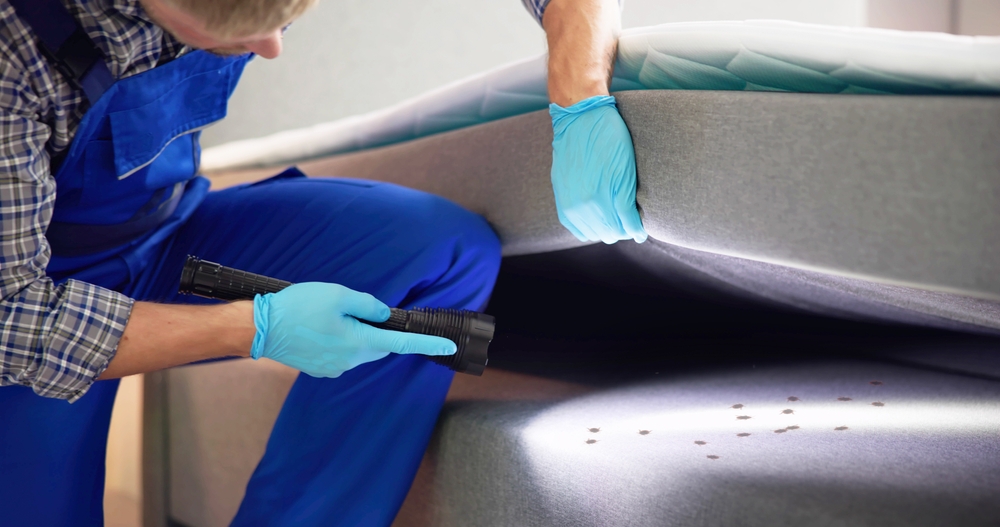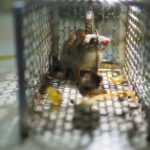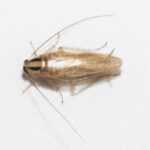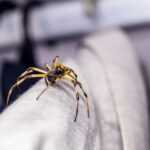Top Bed Bug Treatment Options: Get Rid of Bed Bugs Effectively
Are you looking for effective bed bug treatment options to get rid of these pests quickly? This article will guide you through the best methods, offering both non-chemical and chemical solutions, as well as tips for preventing future infestations.
- Understanding bed bugs’ life cycle and hiding spots is crucial for effective control and prevention of infestations.
- Early detection of bed bugs through physical signs and thorough inspections can significantly reduce treatment costs and complexities.
- Utilizing a combination of non-chemical and chemical treatments, along with professional extermination services, ensures thorough elimination and prevention of future infestations.
Understanding Bed Bugs
Bed bugs are common household pests that can be found infesting beds, furniture, and clothing. These tiny insects, about 5 mm in size—smaller than a pencil eraser—have narrow bodies that enable them to hide in small cracks and crevices during the day, making detection difficult. They are bloodsuckers, feeding on the blood of humans and animals, and are attracted to carbon dioxide, body heat, and smell. This means they often seek out sleeping people or animals for a blood meal, causing itchy bites and discomfort, leading to a bed bug problem. While bed bugs can carry human pathogens, there is currently no evidence that they transmit diseases to humans or animals.
Understanding bed bugs’ behavior helps in controlling them effectively. Their rapid multiplication makes elimination difficult once an infestation is established. Familiarity with their life cycle and common hiding places can enhance efforts in treating and preventing future infestations.
Bed Bug Life Cycle
The life cycle of a bed bug starts with an egg. Bed bug eggs are tiny and white in color. They measure approximately 1/32 inch in length. Upon hatching, the nymphs are yellowish-white and resemble adult bed bugs in shape. Bed bugs go through five nymphal stages before reaching adulthood, with molting occurring between each stage. A blood meal is required after each molting stage, making food availability crucial for their survival.
This life cycle knowledge aids in effective bed bug control. Each developmental stage requires specific conditions, and targeting these can disrupt growth and reproduction, simplifying the elimination process.
Common Hiding Places
Bed bugs are masters at hiding. They often take refuge in:
- the seams and tags of mattresses and box springs
- furniture joints
- picture frames
- wall hangings
- the folds of curtains
- upholstery
Furniture legs are also important to inspect, as bed bugs can hide there. These spots are ideal for placing interceptor traps to detect and prevent infestations.
Regular inspections of these hiding spots can catch bed bug resurgence before it escalates. Frequent checks help identify recurring issues promptly, allowing for quick action and preventing further spread.
Identifying a Bed Bug Infestation
Early identification of a bed bug infestation simplifies treatment and reduces costs. A severe bedbug infestation can be particularly challenging to eliminate and may require professional intervention. Detecting them early prevents extensive infestations, as bed bugs can lay up to 450 eggs and survive for up to 400 days without food. Accurate identification is crucial because control methods may vary based on the insect.
Some professionals use trained dogs to sniff out bed bugs, which helps in confirming an infestation. Spotting a bed bug or suspecting an infestation signals the need for immediate management and elimination.
Signs of Bed Bugs
Physical indicators of bed bugs include rusty stains on bedding, which are the result of crushed bugs, and dark spots of excrement. You might also notice small blood stains on your bed sheets or pillowcases, which occur when bed bugs are disturbed during feeding. These signs are often found near bed bug hiding places, such as mattress seams and furniture joints.
Itchy bites, often found in a line or cluster, are another common sign of bed bugs. If these signs are present, conduct a thorough inspection to confirm their presence.
Inspecting Your Home
A thorough inspection is crucial to identify all the bugs infested areas. Begin with the mattress, box spring, bed frame, headboard, footboard, sheets, and pillowcases, focusing on the trim and seams of the mattress. Also, check cracks and crevices under the box spring.
Inspect upholstered furniture, paying attention to tufts, seams, trim, zippers, undersides, and legs. Check all drawers, frames, and cracks after emptying the furniture. Investigate furniture pieces such as dressers, nightstands, wardrobes, and chairs for bed bugs. Be sure to inspect other furniture near the bed, such as storage containers and chairs, as these can also harbor bed bugs or eggs.
Also, examine cracks in walls, trims, carpets, rug edges, and hidden areas like rails and screw holes. Inspect windows, doors, electrical outlets, and behind outlet covers for hiding bed bugs.
Containing the Infestation
Containing a bed bug infestation quickly is essential to stop these pests from spreading throughout your home. The first step is to wash all bed sheets, clothing, and other fabrics in hot water, then dry them on the highest heat setting. This process kills bed bugs and their eggs hiding in your linens. For items that can’t be washed, such as delicate fabrics or stuffed animals, seal them in plastic bags for several days to trap and starve any bed bugs inside.
Next, thoroughly vacuum all carpets, rugs, and upholstered furniture, paying special attention to areas around bed frames and box springs where bed bugs love to hide. Use a vacuum cleaner with a hose attachment to reach into tight spaces and crevices. After vacuuming, immediately dispose of the vacuum bag or empty the canister into a sealed plastic bag to prevent any surviving bed bugs from escaping back into your home.
For surfaces that can’t be washed or vacuumed, such as mattress seams or furniture joints, use a steam cleaner. The high heat from steam will kill bed bugs and their eggs on contact. To further prevent the infestation from spreading, seal cracks and crevices around windows, doors, and baseboards with caulk or putty. This reduces hiding places and makes it harder for bed bugs to move between rooms.
By acting quickly and containing the infestation, you can make killing bed bugs and eliminating the problem much more manageable.
Preparing for Bed Bug Treatment
Preparation involves several key steps. Begin by scheduling an inspection to assess the infestation and develop a tailored treatment plan. Address factors like frequent travel and clutter, which can complicate detection and removal. While larger infestations are more complicated to eliminate, smaller ones can be harder to detect and manage.
Identifying and isolating the infested room is crucial to prevent bed bugs from spreading during treatment.
Thorough cleaning and using protective covers for mattresses can reduce bed bug hiding places. Regular vacuuming decreases the chance of bringing bed bugs into your home. Wash items in hot water and dry them on the highest heat setting for at least 30 minutes to ensure elimination.
Declutter and Clean
Reducing clutter is a key step in preparing for bed bug treatment. Clutter offers numerous hiding spots, making elimination harder. Remove unnecessary items like cardboard boxes, books, magazines, and toys. Check for any loose wallpaper and glue it down to prevent bed bugs from hiding behind it. Regularly vacuum carpets and upholstery to eliminate bed bugs and their eggs before they become a larger problem.
Clean or discard items such as clothing, drapes, carpets, and linens before treatment. Washing them in hot water and drying on the highest heat setting will help eliminate hiding bed bugs.
Seal Cracks and Crevices
Sealing cracks and crevices creates a barrier against bed bugs, reducing infestation likelihood. Open electrical outlets should also be sealed or covered to prevent bed bugs from hiding or spreading. Use caulk to seal cracks in walls and floors, preventing bed bug movement.
Sealing cracks and crevices limits bed bugs’ movement between units in multi-family homes and deters them from entering your living space.
Non-Chemical Bed Bug Treatments
Non-chemical methods can effectively eliminate bed bugs when applied correctly. Non chemical treatment options, such as heat and cold, are commonly used to kill bed bugs without chemicals and are often part of an integrated pest management approach. These methods often yield better results than home remedies and chemical insecticides. Specialized equipment, such as devices for steaming, heating, or freezing, is necessary for non-chemical controls.
Raising the indoor temperature to at least 115°F (46.1°C) effectively destroys bed bugs, while freezing at 32°F (0°C) also works. Wash affected items in hot water for at least 30 minutes to kill bed bugs.
Heat Treatment
Heat treatment effectively kills bed bugs. Whole room heat treatments require temperatures of 135 to 145°F (57.22 to 62.78°C). Thermal heating systems raise room temperatures to around 145°F, effectively eliminating bed bugs.
Maintaining these temperatures for at least 90 minutes ensures effective treatment. Heat treatments require professional experience and equipment to achieve and sustain these temperatures.
Steam Cleaning
Steam cleaning effectively treats localized bed bug infestations. Direct heat application to mattresses and furniture targets hiding bed bugs. Steam cleaning should be performed at a temperature of at least 200°F (93.3°C) for effectiveness.
Higher temperatures ensure steam penetrates surfaces, killing bed bugs and their eggs. Steam cleaning mattresses and furniture creates an inhospitable environment for bed bugs.
Cold Treatment
Cold treatment effectively eliminates bed bugs from small items. Place items in a freezer set to 0°F or colder for at least four days to ensure all bed bugs are killed.
Wrap items in plastic before freezing to enhance effectiveness. This method is useful for treating small items that cannot undergo heat treatments.
Chemical Bed Bug Treatments
Chemical treatments, especially for larger infestations, are effective. The EPA has approved over 300 pesticide products for bed bugs. The Environmental Protection Agency regulates and approves these products for safety and effectiveness, ensuring they are safe to use and meet strict standards. Common methods include bed bug bombs and foggers, which kill bed bugs instantly, though typically three to four rounds of different treatment methods are needed for effective control.
Using different pesticide classes prevents resistance, ensuring thorough eradication and reducing the likelihood of surviving bed bugs becoming resistant.
Insecticides
Insecticides are primary tools in chemical bed bug treatments to control bed bugs. Use only EPA-registered insecticides specifically indicated for bed bugs to ensure safety and effectiveness. Common insecticides include pyrethrins and pyrethroids.
Stronger insecticides can be more toxic to humans and pets, so exercise caution. Proper application and adherence to safety guidelines are crucial to avoid health risks while ensuring bed bug elimination.
Desiccants
Desiccants, like diatomaceous earth, kill bed bugs by dehydrating them. Unlike chemical insecticides, desiccants do not induce resistance due to their physical mode of action, making them reliable for long-term control.
Desiccants are effective but may take a few months to kill all bed bugs in an infestation. Patience and consistent application are necessary to ensure complete eradication.
Pet-Friendly Bed Bug Treatment Options
If you have pets at home, choosing safe bed bug treatment options is a top priority. Many chemical insecticides used to kill bed bugs can be harmful to cats, dogs, and other animals, so it’s important to select pet-friendly alternatives that are both effective and non-toxic.
One of the best pet-safe solutions is diatomaceous earth. This natural powder works by dehydrating bed bugs, causing them to die without the use of harsh chemicals. Simply sprinkle food-grade diatomaceous earth in areas where bed bugs hide, such as mattress seams, bed frames, and along baseboards. It’s safe for use around pets, but be sure to keep the powder dry and avoid letting your animals inhale large amounts.
Heat treatments are another excellent option for homes with pets. Professional heat treatments raise the temperature in infested rooms to levels that kill bed bugs and their eggs, all without using chemical insecticides. If you’re treating bedding or pet beds, wash and dry them on the highest heat setting to ensure all bed bugs are eliminated.
No matter which method you choose, always follow the instructions carefully and keep your pets away from treated areas until it’s safe. Regularly wash pet bedding and vacuum your home to prevent future bed bug infestations. By using pet-friendly bed bug treatments, you can protect your furry family members while effectively getting rid of bed bugs.
Professional Bed Bug Extermination
If eliminating bed bugs on your own is challenging, bed bug exterminators are recommended. Bed bug exterminators are trained professionals who diagnose, treat, and remove bed bugs using specialized treatment plans tailored to your needs. They are often essential for effectively getting rid of bed bugs, especially in severe infestations, using advanced equipment and methods more effective than over-the-counter solutions. Professional treatments often involve multiple visits and specialized techniques to ensure thorough eradication. Effective eradication may require two to three visits from professionals to ensure all bed bugs are eliminated.
Hiring a professional pest control company minimizes the time spent on extermination and avoids repeated DIY efforts. A professional exterminator has access to specialized chemicals and equipment, making them more effective than DIY methods. They are trained to handle bed bug treatment challenges, including multiple treatment phases and the use of both chemical and non-chemical methods.
Benefits of Professional Help
Professional exterminators use advanced equipment and techniques more effective than DIY methods, ensuring thorough elimination and post-treatment cleanup of insects and their waste. They also implement comprehensive pest management strategies, combining inspection, monitoring, and targeted treatments for effective and environmentally sensitive control.
Professional pest control companies minimize homeowners’ time and effort on extermination, providing an efficient and effective resolution, especially for large or stubborn infestations needing multiple treatment approaches.
Monitoring and Follow-Up
Consistent monitoring confirms that bed bugs have been completely eliminated after treatment. Continue monitoring for several weeks after the initial treatment to catch any resurgence early. Regular inspections of your home and belongings help detect new bed bug activity before it spreads. Using monitoring devices or interceptors makes surviving bedbugs easier to spot, aiding in complete eradication.
Check for bed bug activity every seven days during the control process. Regular post-treatment checks are crucial to ensure complete eradication and prevent future infestations.
Using Bed Bug Interceptors
Bed bug interceptors effectively monitor activity after treatment. These devices trap bed bugs trying to climb onto beds, preventing them from reaching their target and indicating any remaining bugs. To maximize effectiveness, place bedbug interceptors under the legs of beds and other furniture to trap bedbugs and monitor for ongoing activity.
Place interceptors under each leg of the bed to monitor for any remaining bed bugs. This simple yet effective method helps ensure bed bugs do not re-establish themselves in your home.
Regular Inspections
Regular inspections are essential to catch any new bed bug infestations early before they spread throughout your home. Conduct systematic checks of areas such as mattress seams, box springs, and furniture for any signs of bed bugs, including a bed bug inspection.
Focus on areas where bed bugs are likely to hide, including behind headboards and in the folds of curtains. Early detection through regular inspections can prevent a minor issue from becoming a major infestation.
Preventing Future Infestations
Preventing future bed bug infestations requires vigilance and proactive measures. Bed bugs are capable of traveling long distances in search of a host, making it important to be cautious and maintain a clean environment. Finding bed bugs early is crucial to prevent the infestation from becoming established or spreading.
By implementing preventive strategies and maintaining regular inspections, you can significantly reduce the risk of future bed bug problems and keep your home bed bug-free. Prompt action to remove bedbugs is essential for long-term prevention and to ensure that infestations do not recur.
Safe Travel Practices
When traveling, it’s essential to be aware of common public places where bed bugs can be found, such as hospitals, airports, and daycare facilities. Bed bugs can take refuge in the seams of luggage and backpacks, making it easy for them to hitchhike into your home.
After traveling, be cautious and inspect your belongings for any signs of bed bugs. This can help prevent them from making their way into your home and causing an infestation.
Home Maintenance
Regular home maintenance is key to preventing bed bug infestations. Wash sheets and clothing at least once a week to reduce potential bed bug habitats. Maintaining a clean environment through regular vacuuming and inspections can help keep bed bugs at bay.
By keeping your home clean and reducing clutter, you can create an inhospitable environment for bed bugs, significantly lowering the risk of an infestation.
Dealing with bed bugs requires a multifaceted approach that includes identification, preparation, treatment, and prevention. Understanding bed bugs’ behavior and life cycle is essential for effective control. Early detection and thorough inspections can prevent minor infestations from becoming major problems.
Whether using non-chemical or chemical treatments, following proper protocols ensures the best results. For severe infestations, professional help from reliable pest control companies like Gopher Patrol can provide the expertise needed to eliminate bed bugs completely. By implementing preventive measures and maintaining regular inspections, you can keep your home bed bug-free and enjoy a peaceful, pest-free environment.
Frequently Asked Questions
How to get rid of bed bugs?
To effectively eliminate bed bugs, start by vacuuming all surfaces of your bed and washing all linens in hot water, followed by drying them on high heat for at least 30 minutes. Additionally, use protective covers for mattresses and box springs to trap any remaining bugs and remove clutter to minimize hiding spots.
Is it safe to stay in a house with bed bugs?
It is not safe to stay in a house with bed bugs, as they feed on human blood and can cause discomfort and health issues. Taking action to eliminate them should be a priority to ensure a safe living environment.
What kills bedbugs permanently?
Diatomaceous earth, heat treatment, and pyrethrins or pyrethroids are effective methods for permanently killing bed bugs. Employing these methods can ensure complete eradication of these pests from your environment.
How do I know if I have a bed bug infestation?
To determine if you have a bed bug infestation, check for rusty stains on bedding, dark spots of excrement, and itchy bites on your skin. Conduct thorough inspections in common hiding spots for further confirmation.
What are the most effective non-chemical bed bug treatments?
Heat treatment and steam cleaning are the most effective non-chemical methods for eliminating bed bugs. These methods maintain high temperatures for adequate durations, ensuring thorough eradication of the pests.





